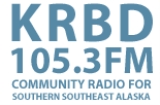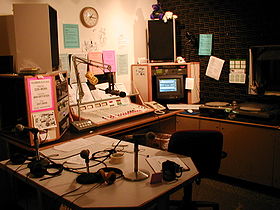
KRBD
Encyclopedia
KRBD is a non-commercial radio station
in Ketchikan, Alaska
, broadcasting on 105.3 FM
. The station airs public radio programming from the National Public Radio network, the BBC World Service
, and is a member of CoastAlaska
. KRBD also airs some locally originated programming.
 As with many radio stations, the name is an abbreviation. In this case, RBD is short for "Rainbird," which is one of the mascots of Ketchikan. (Ketchikan averages about 160 inches of rainfall each year.)
As with many radio stations, the name is an abbreviation. In this case, RBD is short for "Rainbird," which is one of the mascots of Ketchikan. (Ketchikan averages about 160 inches of rainfall each year.)
The station's first broadcast, on May 22, 1976, opened with the song, "The Fool," by Quicksilver Messenger Service on volunteer Tom Miller's show, "Odds and Ends." At that time, the station had seven licensed volunteers, each one covering a day of the week, and each one responsible for recruiting more volunteers.
At first, the station operated out of a single apartment space on the first floor of the 10-story Marine View Building. Its 10-watt transmitter broadcast mostly to listeners within a few miles of Ketchikan's West End neighborhood.
The community licensee was conceived of and built by volunteers. Soon after it went on the air, the station hired a manager/engineer. KRBD continued to grow along with the State of Alaska's oil wealth. Within a few years, the station moved up to the Marine View's 10th floor, where it occupied two large apartment spaces. As it continued to grow, KRBD increased power to its current 5,000 watts and moved to a downtown Ketchikan location at 716 Totem Way, overlooking Ketchikan Creek.
At one point in the 1980s, the station had 10 employees and was able to send them to various training opportunities in and outside of Alaska. Its volunteer crew also grew, numbering as many as 90 in its heyday in the 1980s. KRBD is notable for having a sizable group of youth and teens comprise a portion of the volunteer body.
When the state's budget declined due to lower oil prices, and later due to declining oil production, so did KRBD's. By 2007, the station had about four employees and a much reduced volunteer corp. Throughout its history, volunteers have played an important role in operating the station, especially in producing its varied music programming.
In the early 1990s, the station moved yet again, when it purchased the building at 123 Stedman Street, a few doors down the street from Totem Way. In 2010, KRBD moved to a fifth location known as "The Rock Pit" on Copper Ridge Lane.
Radio station
Radio broadcasting is a one-way wireless transmission over radio waves intended to reach a wide audience. Stations can be linked in radio networks to broadcast a common radio format, either in broadcast syndication or simulcast or both...
in Ketchikan, Alaska
Ketchikan, Alaska
Ketchikan is a city in Ketchikan Gateway Borough, Alaska, United States, the southeasternmost sizable city in that state. With an estimated population of 7,368 in 2010 within the city limits, it is the fifth most populous city in the state....
, broadcasting on 105.3 FM
Frequency modulation
In telecommunications and signal processing, frequency modulation conveys information over a carrier wave by varying its instantaneous frequency. This contrasts with amplitude modulation, in which the amplitude of the carrier is varied while its frequency remains constant...
. The station airs public radio programming from the National Public Radio network, the BBC World Service
BBC World Service
The BBC World Service is the world's largest international broadcaster, broadcasting in 27 languages to many parts of the world via analogue and digital shortwave, internet streaming and podcasting, satellite, FM and MW relays...
, and is a member of CoastAlaska
CoastAlaska
CoastAlaska is an umbrella public radio network for five Southeast Alaskan public radio stations: KRBD, Ketchikan; KSTK, Wrangell; KTOO, Juneau; KFSK, Petersburg; and KCAW, Sitka....
. KRBD also airs some locally originated programming.

The station's first broadcast, on May 22, 1976, opened with the song, "The Fool," by Quicksilver Messenger Service on volunteer Tom Miller's show, "Odds and Ends." At that time, the station had seven licensed volunteers, each one covering a day of the week, and each one responsible for recruiting more volunteers.
At first, the station operated out of a single apartment space on the first floor of the 10-story Marine View Building. Its 10-watt transmitter broadcast mostly to listeners within a few miles of Ketchikan's West End neighborhood.
The community licensee was conceived of and built by volunteers. Soon after it went on the air, the station hired a manager/engineer. KRBD continued to grow along with the State of Alaska's oil wealth. Within a few years, the station moved up to the Marine View's 10th floor, where it occupied two large apartment spaces. As it continued to grow, KRBD increased power to its current 5,000 watts and moved to a downtown Ketchikan location at 716 Totem Way, overlooking Ketchikan Creek.
At one point in the 1980s, the station had 10 employees and was able to send them to various training opportunities in and outside of Alaska. Its volunteer crew also grew, numbering as many as 90 in its heyday in the 1980s. KRBD is notable for having a sizable group of youth and teens comprise a portion of the volunteer body.
When the state's budget declined due to lower oil prices, and later due to declining oil production, so did KRBD's. By 2007, the station had about four employees and a much reduced volunteer corp. Throughout its history, volunteers have played an important role in operating the station, especially in producing its varied music programming.
In the early 1990s, the station moved yet again, when it purchased the building at 123 Stedman Street, a few doors down the street from Totem Way. In 2010, KRBD moved to a fifth location known as "The Rock Pit" on Copper Ridge Lane.

